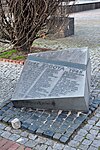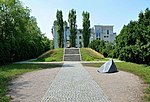Monument to the Ghetto Heroes
1948 establishments in Poland1948 sculpturesHolocaust memorials in PolandMonuments and memorials in WarsawWarsaw Ghetto

The Monument to the Ghetto Heroes (Polish: Pomnik Bohaterów Getta) is a monument in Warsaw, Poland, commemorating the Warsaw Ghetto Uprising of 1943 during the Second World War. It is located in the area which was formerly a part of the Warsaw Ghetto, at the spot where the first armed clash of the uprising took place. The monument was built partly of Nazi German materials originally brought to Warsaw in 1942 by Albert Speer for his planned works. The completed monument was formally unveiled in April 1948.
Excerpt from the Wikipedia article Monument to the Ghetto Heroes (License: CC BY-SA 3.0, Authors, Images).Monument to the Ghetto Heroes
Warsaw Śródmieście (Warsaw)
Geographical coordinates (GPS) Address Nearby Places Show on map
Geographical coordinates (GPS)
| Latitude | Longitude |
|---|---|
| N 52.249722222222 ° | E 20.993888888889 ° |
Address
Warsaw, Śródmieście (Warsaw)
Masovian Voivodeship, Poland
Open on Google Maps











